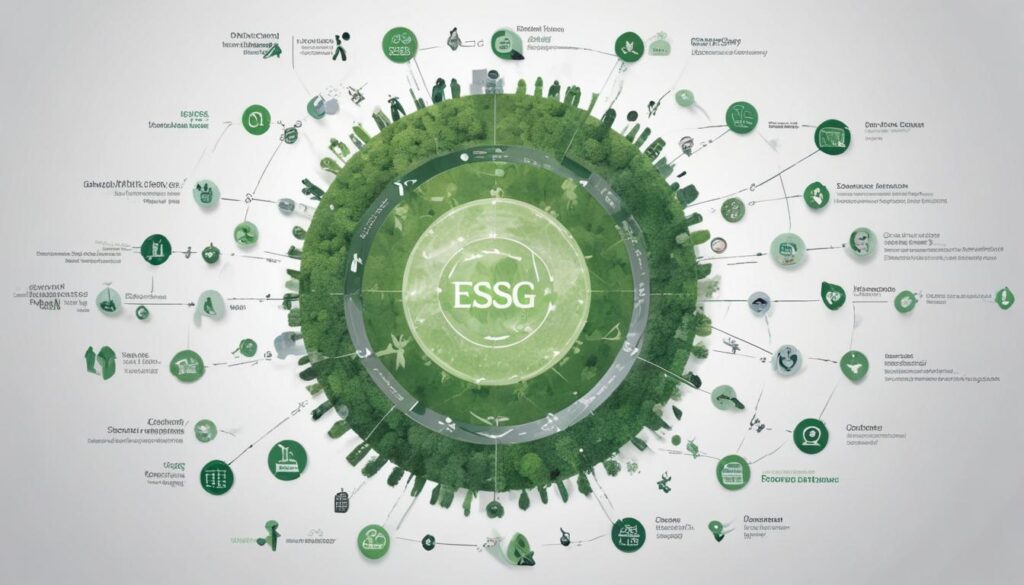ESG reporting is crucial for businesses, as it enhances transparency, attracts investors, mitigates risks, and reflects a company’s commitment to sustainability, ultimately positioning them for long-term success in a rapidly evolving market.
ESG reporting has become a vital tool for businesses seeking to demonstrate commitment to sustainability. This article delves into its components and significance, revealing why it matters in today’s landscape.
What is ESG reporting and why does it matter?
ESG reporting stands for Environmental, Social, and Governance reporting, a framework that allows companies to disclose their sustainability practices and impact. This reporting is essential as it provides transparency around a company’s operations and enables stakeholders to understand their commitments to social responsibility.
A key element of ESG reporting is the demonstration of corporate accountability. Companies can use ESG metrics to showcase their performance in critical areas such as:
- Environmental sustainability practices, such as carbon footprint reduction
- Social contributions to communities and employee welfare
- Effective governance structures that promote ethical practices
Investors are increasingly interested in ESG reporting as a way to assess long-term viability and risk. Poor ESG performance can signal potential risks that may affect financial stability.
Moreover, consumers are more discerning and are likely to support companies that align with their values. This shift in consumer behavior underlines the need for robust ESG reporting. Businesses that effectively communicate their ESG efforts can enhance customer loyalty and brand reputation.
In summary, as the demand for corporate responsibility grows, so does the importance of ESG reporting in providing a roadmap for ethical and sustainable business practices.
Key components of effective ESG reporting
Effective ESG reporting relies on several key components that ensure clarity, accuracy, and relevance. These components help organizations communicate their sustainability efforts and performance effectively to stakeholders.
One of the primary components is transparency. Organizations must be open about their practices, methodologies, and any data used in reporting. This builds trust with investors and customers alike. Another crucial aspect is materiality, which focuses on identifying the most relevant environmental, social, and governance issues impacting the organization and its stakeholders.
Additionally, quantitative metrics play a significant role in ESG reporting. Companies should employ measurable indicators that provide concrete data, such as:
- Carbon emissions and reduction goals.
- Workplace diversity statistics.
- Community investment levels.
Another essential element is stakeholder engagement. Actively involving relevant parties, from employees to customers, can offer insights that enhance the reporting process. These stakeholders can provide valuable feedback on what matters most to them, making the report more impactful.
Finally, regulatory compliance cannot be overlooked. Organizations must stay updated with existing regulations and frameworks to ensure adherence, enhancing the credibility of their ESG disclosures.
The role of ESG reporting in attracting investors

ESG reporting plays a pivotal role in attracting investors who prioritize sustainable and responsible investing. This type of reporting provides a comprehensive view of a company’s commitment to environmental protection, social responsibility, and good governance practices.
Investors today are increasingly aware of the risks associated with poor ESG performance. They seek more than just financial returns; they look for investments that align with their values. Therefore, companies with robust ESG reports can stand out in a crowded market. Key factors that influence investor interest include:
- Transparency of operations and practices.
- Clear progress in achieving sustainability goals.
- Evidence of stakeholder engagement and community support.
Furthermore, companies that demonstrate strong ESG commitments are often viewed as lower-risk investments. As ESG factors are integrated into financial analysis, businesses that fail to report their ESG activities risk losing out on potential funding.
Additionally, many investors use ESG ratings as part of their decision-making process. Positive ratings can enhance a company’s market appeal and potentially lead to a higher valuation. Thus, effective ESG reporting is not just a regulatory obligation; it is also a strategic tool to capture investor interest and build lasting relationships with the finance community.
How ESG reporting helps mitigate risks
ESG reporting is an essential tool for mitigating risks that companies face in today’s complex business environment. By systematically disclosing environmental, social, and governance factors, firms can identify potential issues before they escalate into significant problems.
One major risk that ESG reporting addresses is regulatory compliance. As governments implement stricter environmental regulations, transparent reporting enables organizations to keep abreast of legal requirements. This proactive approach can help prevent costly fines and reputational damage.
Moreover, ESG reporting enhances operational resilience. By assessing and reporting on supply chain sustainability, businesses can identify vulnerabilities, such as reliance on non-sustainable resources. This awareness allows companies to:
- Develop alternative sourcing strategies.
- Build diverse supply networks.
- Lower their carbon footprint.
Additionally, strong ESG practices can improve a company’s relationship with stakeholders, including investors, customers, and employees. When organizations show commitment to social responsibility, they can better manage reputational risks associated with negative public perception.
In times of crisis, such as natural disasters, companies with robust ESG frameworks may recover more swiftly due to established procedures and community goodwill. Ultimately, effective ESG reporting not only safeguards against risks but also positions companies for long-term success and sustainability.
Best practices for implementing ESG reporting
Implementing ESG reporting effectively requires adherence to several best practices that enhance the quality and credibility of the disclosures. One of the first steps is to ensure a comprehensive understanding of the relevant ESG metrics. Companies should identify the specific indicators that align with their industry and stakeholder interests.
Engaging stakeholders throughout the reporting process is essential. This includes not only investors but also employees, customers, and community members. Actively soliciting feedback can help organizations prioritize what matters most. Consider forming cross-functional teams to gather diverse perspectives and insights.
Another best practice is to establish a clear and consistent reporting framework. Organizations can leverage established standards and guidelines such as:
- Global Reporting Initiative (GRI)
- Sustainability Accounting Standards Board (SASB)
- Task Force on Climate-related Financial Disclosures (TCFD)
These frameworks aid in standardizing disclosures, making it easier for stakeholders to assess performance. Additionally, companies should ensure data accuracy by implementing internal controls and audits. This attention to detail can mitigate risks associated with data discrepancies.
Finally, transparency in communication is vital. Companies should present their ESG reports in a way that is accessible and understandable, using visuals and clear language to convey important information. This fosters trust and enhances engagement with stakeholders.
Future trends in ESG reporting and compliance

The future of ESG reporting and compliance is poised for significant transformation as businesses face increasing pressure to enhance sustainability practices. One notable trend is the integration of technology, specifically artificial intelligence (AI) and data analytics, to improve the accuracy and efficiency of reporting. By leveraging these tools, companies can analyze vast amounts of data to measure ESG performance more effectively.
Another emerging trend is the shift towards real-time reporting. Stakeholders now expect companies to provide timely updates on their ESG initiatives rather than waiting for annual reports. This demand for transparency encourages organizations to establish continuous monitoring of their sustainability metrics.
Furthermore, regulatory frameworks surrounding ESG disclosures are becoming more stringent and standardized across various regions. As governments establish clearer requirements, companies will need to adapt their reporting practices. Key aspects of compliance that will likely evolve include:
- Alignment with international standards, such as the Global Reporting Initiative (GRI) and Sustainability Accounting Standards Board (SASB).
- Incorporation of metrics related to climate change and social equity.
- Increased scrutiny from investors focusing on ESG risks and opportunities.
Lastly, shareholder activism is gaining momentum, with investors advocating for stronger ESG commitments. Companies that proactively engage with their shareholders and address ESG concerns will be better positioned in the market.
In summary, understanding ESG reporting is essential for businesses today
Effective ESG reporting not only demonstrates a company’s commitment to sustainability but also attracts investors and mitigates risks. By adopting key practices and staying updated with future trends, organizations can enhance their reputation and operational resilience.
As compliance regulations become stricter, companies that proactively embrace ESG principles will position themselves for long-term success. Integrating technology and engaging stakeholders are vital steps in this journey.
Ultimately, companies that prioritize ESG reporting will not only benefit their bottom line but also contribute positively to society and the environment.
Common Questions About ESG Reporting
What is ESG reporting and why is it important?
ESG reporting provides transparency regarding a company’s environmental, social, and governance practices. It’s important because it helps build trust with investors and stakeholders.
How can ESG reporting attract investors?
Investors are increasingly looking for companies that prioritize sustainability. Strong ESG reports showcase a company’s commitment to long-term value and risk management, making them more appealing.
What are the key components of effective ESG reporting?
Effective ESG reporting includes transparency, materiality, quantitative metrics, stakeholder engagement, and regulatory compliance to ensure accuracy and relevance.
How can technology enhance ESG reporting?
Technology, such as AI and data analytics, can streamline the process of gathering and analyzing ESG data, leading to more accurate and efficient reporting.
What role does stakeholder engagement play in ESG reporting?
Engaging stakeholders is vital as it helps identify priority areas for reporting, ensuring that the ESG metrics reflect the interests and concerns of those affected by the company’s operations.
What future trends should companies watch in ESG reporting?
Companies should prepare for real-time reporting, stricter regulatory frameworks, and increased emphasis on climate change metrics as key future trends in ESG reporting.


